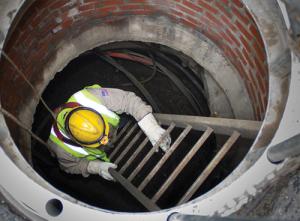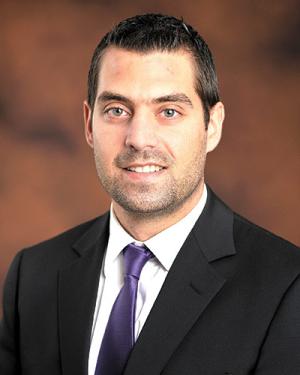Duquesne Light
Josh Gould is Director for Innovation at Duquesne Light Company.
Southwestern Pennsylvania might not have been in your mind as an innovation hub like Silicon Valley, but it is time to change that thinking. PUF brings you here an innovator who points out why the area is a hotbed for the best and brightest, as Duquesne Light Company searches for an answer to what makes a healthy underground distribution network.

The utility has turned to crowdsourcing and is seeking to partner with anyone with answers as to how to find the best way to determine how to make decisions around underground cable repair and replacement. It's a challenge, where cuts are made, and the best solutions rise in each phase of the competition. There is prize money too.
To explain more about the search for a solution, PUF talked with Josh Gould, Director for Innovation at Duquesne Light Company. Enjoy the conversation.
PUF's Steve Mitnick: What is your role at Duquesne Light Company and what is your typical day like?
Josh Gould: With a director of innovation job, you often don't have the same day. That keeps it interesting. I lead our innovation center and am responsible for serving as the principal liaison to external parties focused on innovation.
 Josh Gould: We have prizes associated with the challenge. As you go down the funnel, the value of those prizes goes up as we’re getting more confident this is something you can deploy in a real-world solution.
Josh Gould: We have prizes associated with the challenge. As you go down the funnel, the value of those prizes goes up as we’re getting more confident this is something you can deploy in a real-world solution.
I maintain a portfolio of innovation opportunities, which is a slightly fancy way of saying, as a company, we do innovation work where we partner with third parties and our internal business units to do projects that grow the utility and make us safer, affordable, customer-centric, and more reliable and resilient.
PUF: You're in the city with Carnegie Mellon, Pitt, and a lot of smart people. Do you interact a lot?
Josh Gould: Not everyone appreciates what a hotbed of innovation southwestern Pennsylvania, and specifically Pittsburgh, is. This region can sometimes fly under the radar nationally, and it's tremendous what's happening here. We have Carnegie Mellon, Pitt, and Duquesne University. It's a huge center of robotics, of life sciences, and self-driving.
What we talk about in the innovation center is that it's not always directly focused on the power system and the power sector, but a lot of those pieces, like robotics, are adjacencies that can help us in the power system.
It's tremendous having this in our backyard, and that's where we look to first for innovation. We're lucky to be in this region.
PUF: Pittsburgh was one of the first centers of electrification in the world via George Westinghouse. Some of your distribution grid, a lot of it underground, is showing its years. Have you started looking into that?
Josh Gould: Yes, we have an underground network. We serve greater Allegheny and Beaver counties. In the suburbs and in rural regions of our territory, it's no surprise that it's typically an overhead distribution network.
But in dense urban areas, it's underground, and as you alluded to, some of that network, and the cables in that network, age. Aging in and of itself isn't necessarily a fatal issue for cable. Cable can last effectively for a very long period of time.
The core challenge we're interested in — and are engaging the community and third parties around — is to have better tools to understand the health of that cable. Simply knowing the age of the cable is kind of an imperfect, blunt measurement.
It's not a perfect way to tell the health of the cable. Because you can have a cable that is aged, but is operating effectively, and you can have a younger cable that might be subject to failure.
What we're trying to solve is: How can we better find solutions to inspect, monitor, and understand the health of cable in a way that keeps our employees safe when they perform maintenance, which also keeps the public safe, and improves reliability?
Because if those cables fail in a way we don't anticipate, there can be adverse consequences to reliability. We want to get in front of that. We want to better understand the health of our cable, and the safety of our employees and the reliability of our network is fundamentally why we're doing this.
We believe the more we understand about the health of our cable, the more we can make better decisions around repair and replacement. The more efficient work we can do leads to a more affordable product.
PUF: There is new technology now with sensors and things. Will you look into that?
Josh Gould: Yes. One of the places I used to work is a place called ARPA-E. It's important that all utilities know about ARPA-E. It's the moonshot agency for energy, and the sister agency to DARPA, which are the folks responsible for inventing the internet.
One of the tools both ARPA-E and DARPA use is crowdsourcing. This is a tool you use, where you have a relatively well-defined challenge you want to solve, but you are not nearly as clear on what the solution set is.
For instance, if you're going to go buy a transformer, that's a known solution to a known challenge. Just do a procurement. You don't need crowdsourcing. But if you know what your challenge is — which is better understanding the health of aging cable, maintaining our reliability, and keeping our employees safe — but don't know what the solution is, that's a great candidate for crowdsourcing.
Part of the reason we're using crowdsourcing here is because we want to keep it as open as possible. In other words, if we knew exactly what the solution is, we'd just go and deploy it. We don't need to do crowdsourcing if we know precisely how we're going to address this challenge.
That's why we chose this tool because it's a known challenge. But the solution set is less known, and that's why we're going to throw it open to anyone who's got a good solution.
PUF: What do you expect to come from this?
Josh Gould: Sometimes when people hear crowdsourcing, they're like, oh, it's easy because all you do is just tell people what your problem is and then sit back and wait for the solutions. There's a lot of underappreciated work that goes into defining the problem effectively, and then targeting who you're asking.
Anyone meeting the qualifications and requirements of the challenge can respond, but we're doing a specific outreach. We have some people and entities in mind who might have solutions for this, and we're specifically targeting them. But a lot of that is, again, in how you design the challenge and how you ask the problem.
It's going to be apparent in terms of what we're asking for, that your person in the garage is probably not going to be able to do this alone. They're going to need a partner to provide us the solution. That's built into the challenge model, and it's built into what we're asking for.
PUF: How is this going to work?
Josh Gould: Think of it like a funnel. It's a three-phase process. What we ask for at the beginning is a five-page technical paper. Give us your idea, describe it, and demonstrate how it doesn't violate the laws of thermodynamics or other basic scientific principles.
It's intentionally a lower bar to start with in phase one. Phase two is, you have to demonstrate testing results from a prototype. It doesn't need to be on our electrical network, necessarily. It can be in a lab. But you're going to give us real technical results in phase two, so we're talking numbers here.
Phase three is, you're going to deploy it on an electrical network, and I said a funnel, because there will be no more than five winners from phase one, and no more than two winners from phase two. We're paring down.
We have prizes associated with the challenge. As you go down the funnel, the value of those prizes goes up as we're getting more confident this is something you can deploy in a real-world solution.
We are not the only utility with an underground network. I used to work at ConEd, so I've been in touch with my former colleagues. We are actively open and would be grateful for industry partners to join us.
As a smaller utility than some of our peers, we feel like we're capable of taking the first step. We're capable of driving this to fruition ourselves, for that matter, but we think it'd be better if we have utility partners.
We're explicit about this in the challenge. We're not doing this for marketing and branding purposes; we're doing this to solve a real challenge we have. For that reason, we want to deploy this as quickly as we can while remaining safe.
We're being explicit at the end that we want to get this to contract. It is a fun challenge, but it's also hard work. We're doing this to get a solution to deploy and help our employees and the public be safer while also having a more reliable underground network.
PUF: What kind of feedback do you get from government at the city or state level, or consumer groups?
Josh Gould: What I've heard typically is surprise that a utility is doing something like this, which may be a bit of a backhanded compliment. The part I like is people seem genuinely excited about this new approach and the possibility of uncovering something out of the ordinary.
What this methodology opens up is potential for people in other industries who might have a solution here. Is there a vendor we could uncover who's providing something to traditional cable businesses but comes across this challenge and has something great for us?
Generally, the feedback has been positive. We're excited about the cultural shift this represents among utilities. Defining a challenge to solve and having the confidence to throw it out into the world, in my mind, makes us better. It makes us stronger; it makes us more customer-centric. It's a good first step in that cultural shift, not just for our utility, but the industry.
PUF: Maybe you'll be able to do this with other problems Duquesne Light Company has?
Josh Gould: I hope so. I won't get too specific, but this has been an example of — when you start a new process — how it can uncover things you didn't think of.
Our second innovation challenge is following shortly behind our first. That subsequent challenge is in a very different, non-technical area. It demonstrates that, where you start thinking about this as a potential tool to use to problem solve, you start to see challenges and issues that might be addressed.
With this challenge, I'm excited and hopeful for some innovative solutions that are applicable not only to Duquesne Light, but also our colleagues in the utility industry.
People are going to believe, because of the results we're going to generate here, that this is a tool that can be used for a certain class of challenges: Where the problem or issue is known, but the solution set is less clear.
It's a great tool to use for this. We're going to demonstrate some success along the way, and I hope that will drive adoption of this tool. It's already driving adoption within Duquesne Light, but subsequently I hope it will drive adoption in the broader industry among our utility peers. I'm looking forward to seeing that.

